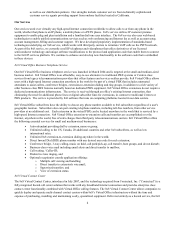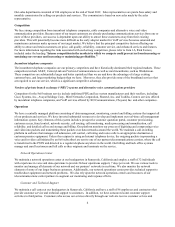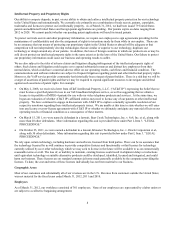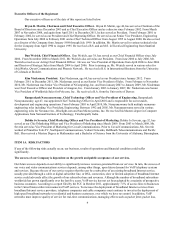8x8 2012 Annual Report Download - page 12
Download and view the complete annual report
Please find page 12 of the 2012 8x8 annual report below. You can navigate through the pages in the report by either clicking on the pages listed below, or by using the keyword search tool below to find specific information within the annual report.
10
and unreliable bandwidth, so that toll-quality service can be consistently provided. VoIP telephony equipment and services
must achieve a similar level of reliability that users of the PSTN have come to expect from their telephone service, and the cost
and feature benefits of VoIP must be sufficient to cause customers to switch away from traditional telephony service providers.
We must devote substantial resources to educate customers and end users about the benefits of VoIP telephony solutions, in
general, and our services in particular. Substantial, ongoing interaction with our customers in order to train and assist them with
the deployment and use of our services over these networks is sometimes required. If any or all of these factors fail to occur,
our business may be affected adversely.
The impact of the current economic climate and adverse credit markets may impact customer demand for our products
and services.
Many of our existing and target customers are in the small and medium business sector. Although we believe our products and
services are less costly than traditional telephone services, these businesses may be more likely to be significantly affected by
economic downturns than larger, more established businesses. They also may be more likely to require working capital
financing from local and regional banks whose lending activities have been reduced substantially since 2008, as a result of
which the existing and target customers may lack the funds necessary to add new equipment and services such as ours.
Additionally, these customers often have limited discretionary funds which they may choose to spend on items other than our
products and services. If small and medium businesses continue to experience economic hardship, this could negatively affect
the overall demand for our products and services, delay and lengthen sales cycles and lead to slower growth or even a decline
in our revenue, net income and cash flows.
Although the majority of our billing arrangements with customers are prepaid, we regularly monitor the percentage of
customers who cease to pay for our services due to closing or downsizing their business. In general, our customers may
terminate their subscriptions for our services on 30 days notice. Even though our customer churn rates improved in fiscal 2012,
we believe that more than 50% of our total customer churn is related to customers’ financial condition and cannot be certain
that we will continue to experience the same improvement in churn rates given current economic conditions. Additionally, the
combination of our sales cycle coupled with challenging economic conditions could have a negative impact on the results of
our operations.
We have a history of losses and are uncertain of our future profitability.
We recorded operating income of approximately $7.2 million for the fiscal year ended March 31, 2012 and ended the period
with an accumulated deficit of $123 million. We recorded operating income of approximately $6.2 million and $4.0 million
for the fiscal years ended March 31, 2011 and 2010, respectively. Although we have achieved operating income in each of our
three most recent fiscal years, we suffered operating losses in each of the three prior fiscal years and may incur operating losses
in the foreseeable future, which may be substantial. We will need to increase revenues in order to generate sustainable
operating profit. Given our history of fluctuating revenues and operating losses, we cannot be certain that we will be able to
maintain operating profitability on an annual basis or on a quarterly basis in the future.
Our business depends on continued and unimpeded access to the Internet by us and our users. Internet access providers
and Internet backbone providers may be able to block, degrade or charge for access to or bandwidth use of certain of
our products and services, which could lead to additional expenses and the loss of users.
Our products and services depend on the ability of our users to access the Internet, and certain of our products require
significant bandwidth to work effectively. Currently, this access is provided by companies that have significant and increasing
market power in the broadband and Internet access marketplace, including incumbent telephone companies, cable companies
and mobile communications companies. Some of these providers offer products and services that directly compete with our
own offerings, which give them a significant competitive advantage. Some of these providers have stated that they may take
measures that could degrade, disrupt or increase the cost of user access to certain of our products by restricting or prohibiting
the use of their infrastructure to support or facilitate our offerings, or by charging increased fees to us or our users to provide
our offerings, while others, including some of the largest providers of broadband Internet access services, have committed to
not engaging in such behavior.
On December 23, 2010, the FCC adopted an order that imposes "network neutrality" obligations on providers of fixed and
wireless broadband Internet access services, with wireless providers subject to a more limited set of rules. Among other things,
the rules: (1) require providers of consumer broadband Internet access to publicly disclose their network management practices
and the performance and commercial terms of their broadband Internet access services; (2) prevent broadband Internet access
providers from blocking lawful content, applications, services, or non-harmful devices, subject to reasonable network
























